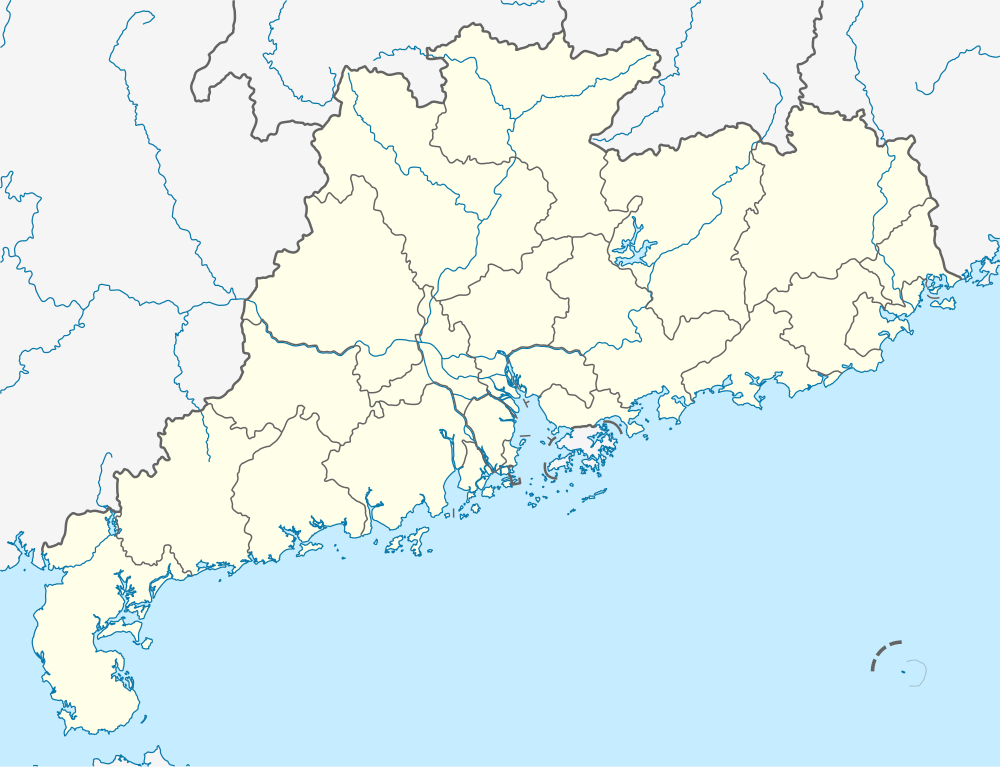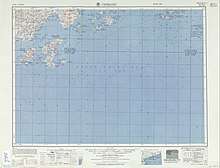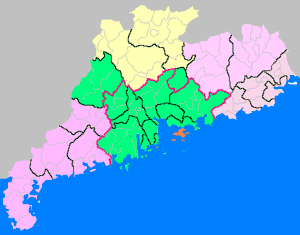Taishan, Guangdong
Taishan or Taishan County, alternately romanized in Cantonese as Toishan, in local dialect as Hoisan or Toisan (臺山) and formerly known as Xinning or Sunning (新寧),[lower-alpha 1] is a county-level city in the southwest of Guangdong province, China. It is administered as part of the prefecture-level city of Jiangmen. During the 2010 census, there were 941,095 inhabitants, of which 394,855 were classified as urban. Taishan calls itself the "First Home of the Overseas Chinese". An estimated half a million Chinese Americans are of Taishanese descent.[3]
Taishan 台山市 Toishan | |
|---|---|
 | |
.png) Location of Taishan City (pink) within Jiangmen City (yellow) and Guangdong | |
 Taishan Location of the city centre in Guangdong | |
| Coordinates: 22°15′07″N 112°47′38″E | |
| Country | People's Republic of China |
| Province | Guangdong |
| Prefecture-level city | Jiangmen |
| Area | |
| • Total | 3,285.91 km2 (1,268.70 sq mi) |
| Population (2010 census) | |
| • Total | 941,095 |
| • Density | 290/km2 (740/sq mi) |
| Time zone | UTC+8 (China Standard) |
| Postal code | 529200 - 529267 |
| Area code(s) | 750 |
| Taishan, Guangdong | |||||||||||||||||||
|---|---|---|---|---|---|---|---|---|---|---|---|---|---|---|---|---|---|---|---|
| Simplified Chinese | 台山 | ||||||||||||||||||
| Traditional Chinese | 臺山 | ||||||||||||||||||
| Postal | Toishan | ||||||||||||||||||
| |||||||||||||||||||
| Former names | |||||||||||||||||
|---|---|---|---|---|---|---|---|---|---|---|---|---|---|---|---|---|---|
| Xinning | |||||||||||||||||
| Traditional Chinese | 新寧 | ||||||||||||||||
| Simplified Chinese | 新宁 | ||||||||||||||||
| Postal | Sunning | ||||||||||||||||
| |||||||||||||||||
Geography
Taishan is located in the Pearl River Delta in southwestern of Jiangmen Prefecture. It contains 95 islands and islets, including Shangchuan Island, the largest island in Guangdong now that Hainan has become a separate province. Taishan is one of Guangdong's "Four Counties" (Sze Yup), which excluded Heshan and is now part of the Greater Taishan Region.
Climate
| Climate data for Taishan (1981−2010) | |||||||||||||
|---|---|---|---|---|---|---|---|---|---|---|---|---|---|
| Month | Jan | Feb | Mar | Apr | May | Jun | Jul | Aug | Sep | Oct | Nov | Dec | Year |
| Record high °C (°F) | 28.2 (82.8) |
29.4 (84.9) |
32.0 (89.6) |
33.4 (92.1) |
35.2 (95.4) |
37.2 (99.0) |
38.3 (100.9) |
37.3 (99.1) |
36.2 (97.2) |
34.2 (93.6) |
32.5 (90.5) |
29.3 (84.7) |
38.3 (100.9) |
| Average high °C (°F) | 18.7 (65.7) |
19.4 (66.9) |
22.3 (72.1) |
26.2 (79.2) |
29.6 (85.3) |
31.2 (88.2) |
32.4 (90.3) |
32.3 (90.1) |
31.0 (87.8) |
28.5 (83.3) |
24.4 (75.9) |
20.4 (68.7) |
26.4 (79.5) |
| Daily mean °C (°F) | 14.2 (57.6) |
15.4 (59.7) |
18.4 (65.1) |
22.6 (72.7) |
25.8 (78.4) |
27.5 (81.5) |
28.4 (83.1) |
28.1 (82.6) |
26.9 (80.4) |
24.3 (75.7) |
20.0 (68.0) |
15.7 (60.3) |
22.3 (72.1) |
| Average low °C (°F) | 11.1 (52.0) |
12.7 (54.9) |
15.8 (60.4) |
20.1 (68.2) |
23.0 (73.4) |
24.9 (76.8) |
25.5 (77.9) |
25.2 (77.4) |
24.1 (75.4) |
21.2 (70.2) |
16.7 (62.1) |
12.4 (54.3) |
19.4 (66.9) |
| Record low °C (°F) | 2.7 (36.9) |
2.7 (36.9) |
3.2 (37.8) |
8.6 (47.5) |
14.1 (57.4) |
18.2 (64.8) |
21.6 (70.9) |
21.9 (71.4) |
16.5 (61.7) |
11.1 (52.0) |
5.0 (41.0) |
2.0 (35.6) |
2.0 (35.6) |
| Average precipitation mm (inches) | 29.5 (1.16) |
60.0 (2.36) |
66.1 (2.60) |
181.2 (7.13) |
289.3 (11.39) |
369.2 (14.54) |
295.1 (11.62) |
329.8 (12.98) |
239.0 (9.41) |
79.4 (3.13) |
36.1 (1.42) |
27.9 (1.10) |
2,002.6 (78.84) |
| Average relative humidity (%) | 74 | 81 | 83 | 84 | 83 | 84 | 82 | 83 | 80 | 74 | 70 | 68 | 79 |
| Source: China Meteorological Data Service Center | |||||||||||||
History
During the Ming dynasty, the area of present-day Taishan was carved out of Xinhui County on 12 February 1499 as Xinning County. Xinning was a source of migrant and emigrant workers, but a series of natural and political disasters in the 19th century exacerbated the situation. Aside from the disruption of the Sea Ban regulations (Haijin) themselves, their revocation led to an influx of northern settlers who began long-running feuds with the returning locals; this erupted into full-scale war in the 1850s and '60s.[4] The 1842 Treaty of Nanjing that ended the First Opium War opened China to greater foreign trade just before the California Gold Rush made the prospect of emigration to the United States appealing. Many also served as contract workers abroad, as in Hawaii and Cuba and—most famously—for the Central Pacific half of America's Transcontinental Railroad, where the Chinese made up 80% of the company's workforce as they laid track over the mountains and deserts of the west.[5] By 1870, there were 63,000 Chinese in the United States, almost all in California.[6]
Chin Gee Hee's Sun Ning Railway Company connected Xinning with its hinterland in 1908 and reached Jiangmen in 1913. It was notable as one of only three financed, built, owned, and run by the Chinese themselves before the 1949 Communist victory in the Chinese Civil War.[7]
In 1914, the new Republican government renamed the area Taishan County to avoid confusion with other places named Xinning.[8][9] (It is now, however, frequently confused in foreign sources with Mount Tai in Shandong.) During the Second World War, the Xinning Railway was destroyed to prevent its use by the Japanese.[7] Japanese soldiers entered Taicheng, the county seat, in March 1941 and killed nearly 280 people.
Taishan was promoted to county-level city status on 17 April 1992, reflecting its increasing level of urbanization.[9]
Administration

A part of Jiangmen, Taishan covers 3,286 km2 (1,269 sq mi) and is subdivided into 16 towns, which are in turn subdivided into 313 village residential committees (村居委会) and 3,655 natural villages (自然村).[9]
These Towns are:
| Name | Chinese (S) | Hanyu Pinyin | Population (2010)[10] |
|---|---|---|---|
| Taicheng Subdistrict | 台城街道 | Táichéng Jiēdào | 246,844 |
| Dajiang town | 大江镇 | Dàjiāng Zhèn | 46,674 |
| Shuibu town | 水步镇 | Shuǐbù Zhèn | 42,578 |
| Sijiu town | 四九镇 | Sìjiǔ Zhèn | 37,402 |
| Baisha town | 白沙镇 | Báishā Zhèn | 52,462 |
| Sanhe town | 三合镇 | Sānhé Zhèn | 36,215 |
| Chonglou town | 冲蒌镇 | Chōnglóu Zhèn | 32,483 |
| Doushan town | 斗山镇 | Dòushān Zhèn | 48,229 |
| Duhu town | 都斛镇 | Dōuhú Zhèn | 42,657 |
| Chixi town (Chihkai; Chihchi) | 赤溪镇 | Chìxī Zhèn | 34,450 |
| Duanfen town | 端芬镇 | Duānfēn Zhèn | 45,729 |
| Guanghai town | 广海镇 | Guǎnghǎi Zhèn | 43,465 |
| Haiyan town | 海宴镇 | Hǎiyàn Zhèn | 73,212 |
| Wencun town | 汶村镇 | Wèncūn Zhèn | 49,565 |
| Shenjing town | 深井镇 | Shēnjǐng Zhèn | 52,767 |
| Beidou town | 北陡镇 | Běidǒu Zhèn | 28,091 |
| Chuandao town | 川岛镇 | Chuāndǎo Zhèn | 28,272 |
- Taicheng (台城街道): sub-district and seat of the city but formerly a township.
- Beidou (北陡镇): separated from other townships by Zhenhai Bay (镇海湾).
- Haiyan (海宴镇): site of an Overseas Chinese farm (华侨农场).
- Chuandao (川岛镇): includes Shangchuan and Xiachuan islands, and has been declared an Integrated Open Tourism Experimental Zone (旅游开发综合试验区).
These “Natural Villages” (自然村) include:
- Annanjiangchao (安南江潮).
- Bihou (庇厚).
- Jilong.
- Guanbuli (官步里).
Demographics
If considering the total Greater Taishan Region or Sze Yap Region, which includes Kaiping, Xinhui, Enping and Taishan, there are about 8 to 9 million Taishanese people worldwide. According to American historian Him Mark Lai, approximately 430,000 or 70% of Chinese Americans in the 1980s were Taishanese according to 1988 data.[11] Currently some 500,000 Chinese Americans claim Taishanese origins.[11]
While Taishan itself has a population of about 1 million, there are around 1.3 million Taishanese people overseas, distributed in 91 countries and regions.[12] It is estimated that, up to the mid- to late-20th century, over 75% of all overseas Chinese in North America claimed origin in Taishan, so Taishan has been named the "Home of Overseas Chinese."[3][13]
Language
The main language of Taishan is Taishanese (台山話). While most Taishanese today use Mandarin in school or formal occasions, Taishanese is the de facto language. Schools require their students to speak Mandarin in the classroom, and teachers are required to lecture in Mandarin.
Taishanese is a language of the Yue Chinese, a large group which includes, but is broader than, the Cantonese spoken in Hong Kong and Guangzhou. Thus Cantonese and Taishanese are related but distinct. Cantonese is also widely known in Taishan, as it serves as the lingua franca of Guangdong Province.
Before the 1980s, Taishanese was the predominant Chinese language spoken throughout North America's Chinatowns.[3]
Claims to fame
Sports
Taishan is the birthplace of Chinese volleyball which was introduced by Overseas Chinese. Its teams have won many provincial and national championships.
Music
Taishan and Guangzhou are the birthplaces of Guangdong music.
War Pilots
One quarter of the "Flying Tigers" came from Taishan. This legendary group of American airmen fought the Japanese before the United States entered the Second World War.[14]
Music and Entertainment
Taishan hosts Jiangmen Star Park which has produced more international Chinese celebrities than any other region or city in China.
Parts of the movie Let the Bullets Fly were filmed in Taishan in 2010.[15][16]
Power stations
Electricity for Taishan is generated by the:
Education
Education enjoys significant support from Overseas Chinese professionals and businessmen. Many secondary schools were built and financed by Chinese living in the Special Administrative Regions, as well as various foreign countries, such as the United States, Canada, and Brazil. To honour their benefactors, these schools often bear their names or the names of their parents.
Peng Quan School (鹏权中学) is a prime example, which was constructed during 1999–2001, and is now integrated into Taishan's public school system. It is situated on the west side of Taicheng, and was built by a Hong Kong businessman.[17]
There are many middle schools and high schools in Taishan, but no academic universities. Students must study rigorously in order to be accepted at universities located in other cities.
Taishan schools include:
University:
- Taishan Panshi Television University (台山磐石电视大学)
Secondary schools (including combined junior-senior high schools and senior high schools):
- Taishan No. 1 High School (台山第一中学)
- Taishan Overseas Chinese Middle School (台山市华侨中学)
- Taishan Peiying Vocational Technical School (台山市培英职业技术学校)
- Taishan Taishi Senior High School (台山市台师高级中学)
- Taishan City Peng Quan School (台山市鹏权中学)
- Taishan Litan Gengkai Memorial Middle School (台山市李谭更开纪念中学)
- Taishan Peizheng School (台山培正中学)
- Taishan Renyuan Middle School (台山市任远中学)
- Taishan Guang Hai School (台山广海中学)
- Taishan Shuibu Middle School (台山市水步中学)
- Taishan Lishufen Memorial Middle School (台山市李树芬纪念中学)
- Taishan Chonglou Middle School (台山冲蒌中学)
- Taishan Xueye Junior Middle School (台山市学业初级中学)
- Taishan Xinning Middle School (台山市新宁中学)
- Taishan Yizhong Dajiang Experimental Middle School (台山一中大江实验中学)
- Taishan Najin Middle School (台山市那金中学)
- Taishan Ningyang Middle School (台山宁阳中学)
Notable people
- Adrienne Clarkson: Broadcast journalist and Governor General of Canada (1999–2005).
- Alan Chin: American contemporary artist.
- Anna May Wong: International movie star.
- Annie Wu Suk-ching: Founder of Beijing Air Catering Ltd. and member of the Standing Committee of the National Committee of Chinese People's Political Consultative Conference.
- Anthony Wong: Award-winning British Hong Kong actor, screenwriter and film director.
- Arthur Chin: Kuomintang fighter pilot and flying ace.
- Bill Lann Lee: U.S. Assistant Attorney General for Civil Rights in the Clinton Administration.
- Chen Yunchang: Actress considered to be the third "Queen of Chinese Cinema".
- Chin Siu Dek: Grandmaster of Kung Fu San Soo.
- Danny Chan: Hong Kong singer.
- Donnie Yen: Hong Kong Chinese martial artist, actor, director, fight choreographer and producer.
- Ed Lee: Mayor of San Francisco (2011–2017), born in Seattle but parents were immigrants from Taishan
- Evan Low: Mayor of Campbell, California.
- Flora Chan: Hong Kong actress and singer.
- Frances Yip: Hong Kong singer.
- Gary Locke: Governor of Washington State (1996–2006), U.S. Secretary of Commerce (2009-2011) and U.S. Ambassador to China (2011–2014).
- Gordon Lam: Hong Kong actor.
- Hiram Fong: U.S. Senator from Hawaii (1959-1977).
- Hu Die: Actress considered to be the first "Queen of Chinese Cinema".
- Inky Mark: Canadian politician, mayor of Dauphin (1994-1997) and Member of Parliament (1997-2004).
- Jack Yan: Magazine publisher in New Zealand.
- James Hong: American actor with over 500 television, film and video game credits, and former civil engineer.
- James Tak Wu: Founder of Maxim's Catering Limited, Hong Kong's largest food and beverage corporation and restaurant chain.
- James Wong Howe: American cinematographer.
- John Tsang: Financial Secretary of Hong Kong.
- Julius Chan: Prime Minister of Papua New Guinea (1980-1982, 1994-1997, 1997).
- Karl Maka, (Chinese: 麥嘉) Hong Kong film producer, director, actor and presenter.
- Ken Hom: American chef, author and television-show presenter.
- Kin W. Moy: American diplomat, Deputy Assistant Secretary of State and former Deputy Executive Secretary in the Office of Secretary of State Clinton.
- Kylie Kwong: Australian chef, restaurateur, author and television-show presenter.
- Leland Yee: California State Senator and convicted arms dealer.
- Li Enliang: Chinese civil engineer and educator.
- Margaret Chin: American politician on the New York City Council representing Chinatown.
- Matt Fong: Treasurer of the State of California (1995-1999).
- Mel Chin: American contemporary conceptual artist.
- Myolie Wu: Hong Kong actress and singer.
- Norman Kwong: championship-winning Canadian football player (1948, 1954, 1955, 1956) and Lieutenant-Governor of Alberta (2005-2010).
- Patrick Soon-Shiong: Surgeon, billionaire and inventor of protein nanoparticle technology.
- Patrick Yu: Hong Kong lawyer, Crown Counsel and founder of its first law school.
- Wong Koon Chung: Lead guitarist for Beyond.
- Raymond "Shrimp Boy" Chow: Mobster and Dragon Head of the San Francisco Chinese Freemasons.
- Shawn Yue: Hong Kong actor and singer.
- Tony Leung: Hong Kong actor.
- Tyrus Wong: American painter, muralist, ceramicist, lithographer, designer and kite maker.
- Wong Ka Keung: Bassist for Beyond.
- Wong Ka Kui: Lead singer of Beyond.
- Wong Kim Ark: Defendant in United States v. Wong Kim Ark - 169 U.S. 649 (1898).
- Wu Lien-teh: Nominee for the Nobel prize in physiology or medicine
- Yip Sai Wing: Drummer for Beyond.
Transportation
.jpg)
Taishan is accessible by bus with a long-distance bus station in Taicheng, and through a port at GongYi on the Tan River which flows into the Pearl River Delta. The ferry service between GongYi and Hong Kong has been discontinued.
Ferry services connect the island of Shangchuan with the mainland, sailing between Sanzhou Harbour (三洲港) on Shangchuan Island and Shanzui Harbor (山咀港) in Chuandao Township. There are also daily ferry services between Sanzhou Harbour and the nearby island of Xiachuan.[18][19]
Taishan is served by the Shenzhen–Zhanjiang high-speed railway, opened in 2018. The Taishan Railway Station (台山站; 22.302197°N 112.810171°E) is located in within Taicheng Subdistrict, some 7 kilometers (4.3 mi) north of Taishan city center. The station has a couple dozen trains a day to Guangzhou South Railway Station.
Notes
References
- Encyclopædia Britannica, 9th ed. (1878), Vol. V, "China".
- Gützlaff, Charles, China Opened, p. 526.
- Pierson, David (2007-05-11). "Taishan's U.S. well runs dry". Los Angeles Times. Retrieved 2008-11-11.
- "Official Web of Taishan-Overseas Chinese Hometow". Tsinfo.com.cn. Archived from the original on 2013-04-29. Retrieved 2014-01-05.
- Mutze. "Remembering origins from Taishan, China" DailyQi. 2008-11-03
- ""From Gold Rush to Golden State". California history Collection". Memory.loc.gov. Retrieved 2014-01-05.
- Chinese Emigration, the Sunning Railway and the Development of Toisan by Lucie Cheng and Liu Yuzun with Zheng Dehua, Amerasia 9(1): 59-74, 1982.
- Ling Huping, Chinese Chicago: Race, Transnational Migration, and Community since 1870, p. 20.
- http://www.cnts.gov.cn/Disp.Aspx?ID=1753&ClassID=65
- shi, Guo wu yuan ren kou pu cha ban gong; council, Guo jia tong ji ju ren kou he jiu ye tong ji si bian = Tabulation on the 2010 population census of the people's republic of China by township / compiled by Population census office under the state; population, Department of; statistics, employment statistics national bureau of (2012). Zhongguo 2010 nian ren kou pu cha fen xiang, zhen, jie dao zi liao (Di 1 ban. ed.). Beijing Shi: Zhongguo tong ji chu ban she. ISBN 978-7-5037-6660-2.
- Wu, Olivia (February 18, 2007). "Young Americans find roots in China: S.F. program offers history and genealogy, helps locate relatives". San Francisco Chronicle. p. 1. Retrieved 2008-12-24.
- http://www.tsinfo.com.cn/en/index.htm
- Dreaming of Gold, Dreaming of Home by Madeline Y. Hsu, Stanford University Press, Stanford CA 2000, page 3.
- "webmail http://webmail.ovh.net". Overseaschinesenetwork.com. Archived from the original on 2014-01-06. Retrieved 2014-01-05. External link in
|title=(help) - Kaiping Location of "Let the Bullets Fly", CRI English.com, 3 December 2010
- Travel Around Taishan, CNTV, March 2011
- tspqz.com
- Shanzui-Shangchuan ferry schedule for 2007 (in Chinese)
- Transportation information for Shangchuan Island (in Chinese)
External links
| Wikimedia Commons has media related to Taishan, Guangdong. |
| Wikivoyage has a travel guide for Taishan. |
